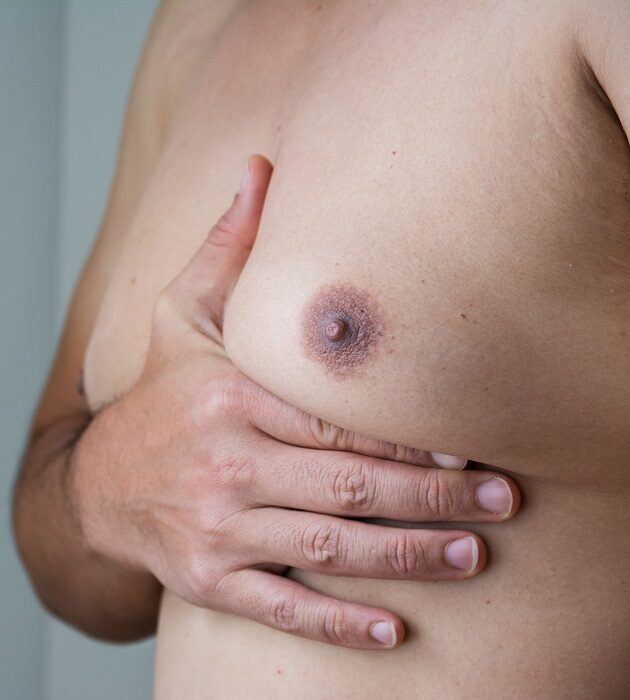



Male Breast Reduction in Rockford, IL
Gynecomastia is a condition characterized by enlarged male breast tissue. Nearly half of all men experience gynecomastia at some point in their lives, with teenage boys and older men most likely to be affected. Although gynecomastia does not pose serious health problems, it does feminize the male physique by adding excess curvature to the chest.
Men who wish to restore a more traditionally masculine chest may seek plastic surgery to address gynecomastia. Board-certified plastic surgeon Dr. Pedro Rodriguez performs male chest contouring surgery to flatten the chest and achieve nicer contours for the patient.


The Pedro Rodriguez Difference
Dr. Pedro Rodriguez is an elite plastic surgeon who performs cosmetic and reconstructive surgery. He specializes in breast, body and face procedures. Merging advanced techniques with his keen eye, he produces transformative results for his patients that are both attractive and natural-looking.
Patients in Rockford choose Dr. Rodriguez because of his outstanding surgical skills and attentive care. Through decades of experience, he understands precisely how to rejuvenate the face and achieve appealing breast and body contours. He takes pleasure in helping his patients build confidence by reaching their aesthetic goals.

Causes of Gynecomastia
Most often, gynecomastia can be attributed to a hormonal imbalance. Because hormone levels fluctuate significantly during puberty, teenage boys are susceptible to estrogen enlarging the chest. The male body also produces less testosterone as it ages, which leaves older men similarly at risk for an increase in glandular tissue.
Other factors that may contribute to gynecomastia include obesity, certain prescription medications and drug and alcohol use. Identifying the likely cause of gynecomastia can help Dr. Rodriguez determine the optimal treatment for each patient.
Gynecomastia Consultation with Dr. Rodriguez
During a consultation, Dr. Rodriguez examines the breast tissue to determine the extent of gynecomastia and whether treatment is appropriate. In many men and teenage boys, gynecomastia goes away on its own, so he may suggest switching a prescription medication or giving it time to see if surgery proves unnecessary. Generally, the best candidates for male breast reduction surgery have had enlarged breast tissue for more than a year.
If both Dr. Rodriguez and the patient agree that surgery is appropriate, Dr. Rodriguez will devise a surgical plan. He has two ways to surgically treat gynecomastia: liposuction and tissue and skin excision. Liposuction tends to work better for patients with mild cases of gynecomastia, while removing excess skin and tissue is the better approach for men with more severe gynecomastia (or who have stretched and sagging skin due to the enlarged size of the chest). In many cases, Dr. Rodriguez may suggest combining these approaches to attain the best results.
Male Chest Contouring Surgery
Male breast reduction surgery is an outpatient procedure. Dr. Rodriguez ensures that his patient stays comfortable during the procedure by providing general anesthesia. While incisions are a necessary component of all surgery, Dr. Rodriguez makes incisions that go around the areola or along the natural crease of the chest to better conceal any scarring. Through these incisions, he can remove excess fat, glandular tissue and skin. He molds the remaining tissue to achieve smoother, more masculine contours. Once complete, Dr. Rodriguez sutures the incisions.
Male Breast Reduction Recovery
Gynecomastia patients return home after their surgery and should prioritize rest and relaxation for the first couple days. Some amount of discomfort should be expected, but prescribed medication can help to minimize pain. Most patients feel well enough to resume work within a week, though this depends on the rigors of the job. Strenuous exercise should be avoided for a few weeks to give the chest sufficient time to heal. Dr. Rodriguez can provide a more concrete timetable on activity during the patient’s follow-up appointments.

Male Chest Contouring FAQs
What should I wear after gynecomastia surgery for optimal healing?
After gynecomastia surgery, Dr. Rodriguez recommends his patients wear a compression garment. This helps to reduce swelling, provide support, and help the skin conform to the new chest contour. Typically, the compression garment should be worn for several weeks post-surgery, but your surgeon will provide specific guidelines based on your individual case.
Is gynecomastia surgery covered by insurance?
Male chest contouring is considered a cosmetic procedure. Because it is not a medically necessary surgery in most cases, it is not covered by most insurance policies. However, our practice offers various financing options to make gynecomastia surgery more accessible. We partner with healthcare financing companies (PatientFi, Alphaeon Credit, Care Credit, and Lending USA) that provide flexible payment plans to fit different budgets. During a consultation, our team can guide patients through the application process.
Can gynecomastia come back after surgery?
Gynecomastia surgery removes excess fat and glandular tissue, making it unlikely for the condition to recur if post-operative guidelines are followed. However, significant weight gain, steroid use, or medical conditions affecting hormone levels could potentially lead to a recurrence. Maintaining a stable weight and healthy lifestyle can also help prevent gynecomastia from returning.
How can I maintain my male chest contouring results for the long term?
To maintain results from male chest contouring surgery, follow a consistent diet and exercise regimen. Keeping your weight stable is crucial as weight fluctuations can alter your results. Regular exercise helps maintain muscle tone and overall body contour. Avoiding drugs known to affect hormone levels, such as steroids, is also important.
Can I exercise away gynecomastia?
Exercise can help in managing body fat and improving overall physical appearance, but it cannot resolve gynecomastia if it’s caused by glandular tissue growth. Gynecomastia, which is primarily the result of excess glandular tissue, will likely require surgical intervention to remove the tissue. Exercise can complement surgery by toning the chest muscles and enhancing the contours of the chest post-surgery.
Will there be scars after male chest contouring surgery?
Scarring from male chest contouring surgery depends on the specific techniques used and the extent of the excess tissue that needs to be removed. Typically, Dr. Rodriguez makes incisions in less visible areas such as around the areola or in the natural chest creases, which helps minimize visible scarring. Over time, these scars should fade and become less noticeable. Post-operative care instructions will also include guidelines on how to care for the scars to ensure the best possible healing process.

Can a patient be too young for male chest contouring surgery?
The appropriate age for male chest contouring surgery depends on both physical maturity and emotional readiness. Typically, it’s advisable to wait until any adolescent growth spurts have finished, and the condition of gynecomastia has stabilized. This often means waiting until the late teens or early adulthood. Surgery may be considered earlier if gynecomastia causes significant emotional distress. During a consultation, Dr. Rodriguez can help determine the right timing based on individual health and developmental factors of the patient.
Can gynecomastia go away on its own?
In teenagers, gynecomastia is frequently temporary and may resolve without intervention. However, in adult males or in persistent cases, the enlarged tissue may not respond to hormonal normalization or weight loss, and surgical correction may be considered.
How do I know if I need liposuction or glandular tissue removal?
Determining the appropriate surgical approach depends on the composition of the breast enlargement. If the excess volume is primarily fatty tissue, liposuction may be sufficient. If firm glandular tissue is present, direct excision is typically required, sometimes in combination with liposuction for contouring. During consultation, Dr. Rodriguez performs a physical examination and may use imaging or other diagnostic tools to differentiate between fat and glandular components.
What are some common myths and misconceptions about gynecomastia?
A common misconception is that gynecomastia is solely caused by excess body fat. In reality, it often involves true glandular enlargement, which does not respond to diet or exercise. Additionally, some assume the condition is always linked to steroid use or medication, but many cases have no identifiable cause (idiopathic gynecomastia).
Will I have noticeable scars after gynecomastia surgery?
While all surgery involves scarring, careful incision placement and proper wound care can reduce visibility. Incisions for male breast reduction are typically placed around the edge of the areola, where they are naturally concealed. Small access points are used in cases requiring liposuction only, which usually heal with minimal visibility. Dr. Rodriguez provides detailed aftercare instructions to support optimal healing.
At what age does gynecomastia usually develop?
Gynecomastia commonly appears during puberty due to hormonal shifts and often resolves within a year or two. It can emerge at any point for adult men and may persist without intervention. Evaluation is appropriate if the condition lasts beyond adolescence or causes physical or functional concerns.
Is male chest contouring only for patients with gynecomastia?
No. While gynecomastia is the most common reason patients seek male chest contouring, variations on this procedure may also be appropriate for individuals who have lost significant weight and are left with residual fat or redundant chest skin. Others may pursue contouring to address asymmetry, refine pectoral definition, or correct the effects of aging on chest appearance. The treatment plan is developed based on individual anatomy and goals.
Will the results of male chest contouring be permanent?
The glandular tissue that is surgically removed does not typically regenerate. However, significant weight gain, hormonal changes, or use of certain medications may lead to the recurrence of fat in the chest area. Long-term results are best maintained by avoiding substances known to trigger gynecomastia, such as anabolic steroids or certain recreational drugs, and by maintaining stable weight.
Can male chest contouring be combined with other procedures?
Yes. Male chest contouring is sometimes performed alongside additional body contouring procedures, such as liposuction of the abdomen or flanks, particularly in patients seeking comprehensive reshaping after weight loss. If a patient expresses interest, Dr. Rodriguez evaluates overall body proportions and discusses whether a combined approach would help achieve a more balanced and proportional result.

Schedule an Appointment
The good news is that you do not need to tolerate gynecomastia indefinitely. If you would like to improve the shape of your chest with male breast reduction surgery, please reach out to Dr. Rodriguez’s office to arrange a consultation.





